Are you a Quiet Speculation member?
If not, now is a perfect time to join up! Our powerful tools, breaking-news analysis, and exclusive Discord channel will make sure you stay up to date and ahead of the curve.
We’re less than a fortnight away from Grand Prix Dallas, the first big-stage Modern event in what seems like forever. I’m pumped, even though I won’t be playing, as I recently returned from Dallas, Texas on an architectural field study and that place is freakin’ awesome. Why that matters to you I can’t imagine, but still, here we are. What does matter is that for the immediate future, GP Dallas is poised to shape Modern as we know it until the next big event. We’ve gone long enough without an under-the-lights, trial-by-fire gauntlet of high-profile, high-skill competitive play to stress-test the format, which has allowed monstrosities like this deck I mistakenly gave a chance to flourish. For better or for worse, GP Dallas is going to change Modern. It’s time to start getting prepared.

For those like me who don’t plan more than a week ahead for anything, Dallas is November 4-6, or a week and a day from time of posting of this article. Normally, for those just starting to prepare for a large event, a week’s worth of time is hardly enough to gain a clear understanding of the format. Lucky for us, however, Star City Games showcased Modern as their format of choice for their Open Series in Milwaukee last week, which means we have some strong information to analyze for our preparation for Dallas. We’ll start, as we always do, with a macro look at the archetype representation in both the Top 8 and the Top 16.
[wp_ad_camp_1]
Top 16 Archetype Representation
- 5 Dredge
- 3 Infect
- 2 Affinity
- 1 Bant Spirits*
- 1 Ad Nauseam*
- 1 Titan Shift
- 1 Jeskai Control
- 1 Zoo
- 1 Bant Eldrazi
*denotes finals appearance
Looking at the Top 16, immediately apparent in the data is the strong performance of both Dredge and Infect. Infect has consistently been one of the “big three” of Modern, pretty much ever since Eldrazi got nerfed. Dredge has wavered between dominant performances that brought up the "best deck" conversation to horrid showings due to the level of sideboard hate. To see it here suggests that players have been skimping on hate in their boards of late. Beyond the big two, Affinity is the only other archetype to put more than a single copy into the Top 16—this would be of interest, except it’s Affinity, and we all know exactly what to expect from that archetype by now.
As for the singletons, Bant Spirits is the only newish archetype to pop up here, and Jeskai Control deserves an honorable mention as a reminder of ages long forgotten (like what would happen if Ronald Reagan decided to crash a current Presidential debate, I guess). As a general takeway, looking purely at Top 16 data, Dredge and Infect seem to be the top targets for anyone looking to attack the metagame, and the absence of Burn and Jund is interesting as well. On to the Top 8!
Top 8 Performances – SCG Milwaukee
- Bant Spirits
- Ad Nauseam
- Dredge
- Titan Shift
- Affinity
- Jeskai Control
- Zoo
- Dredge
What a different story! Two of the singleton archetypes from the Top 16 bypassing the archetypes with stronger representation to meet in the finals, with the sole rogue deck taking down the whole thing?! This is what Michael Bay movies are made of (if we took out the whole plot and replaced them with gigantic shiny robots).
Looking at the Top 8 and the Top 16 data side by side, the biggest takeaway here is both Dredge and Infect’s poor translation from the Top 16 to the Top 8. Five copies of Dredge suggests a very strong performance, so seeing only two move forward into Top 8 (and no copies make the finals) does seem a disappointment to me as far as that archetype’s performance is concerned. As for Infect, three copies in the Top 16 (the second most represented archetype) suggests a strong performance as well, but zero copies in the Top 8 puts forth an entirely different narrative. How can we explain such disparity in the lists?
When looking at data like this, I’ve found that the solution can be one of two hypotheses. One, it’s possible that both archetypes were well set up to fight against the field, but fared poorly once they made it through the early rounds and into the "winner’s circle" metagame. The archetypes you face in rounds one to six can often look like an entirely different reality compared to the decks you face in the later rounds of an event, especially in a field as wide open as Modern. When players are piloting over 20 different archetypes at various levels of viability, it’s very likely that a strong, consistently powerful strategy would do well at cutting through the noise, and then possibly failing once they reached the top tier. For Infect and Dredge, this definitely seems possible, as both archetypes (along with Affinity and Burn) are fast, consistent, powerful, and do relatively the same thing regardless of matchup.
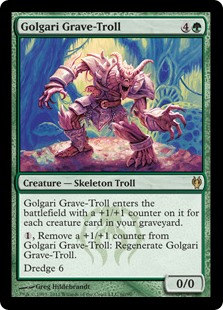 As for the second possibility, Dredge and Infect decks may have come into a hostile field, and brute-forced their way to the Top 16 before they eventually fell victim to bad matchups and prepared opponents. This sort of narrative is almost impossible to prove, due to the randomness associated with every player’s varying matchup experience on game day. (By "experience," I mean the specific narrative of the multitude of matchups they personally faced in their rounds, and not their player skill piloting the deck.) One Dredge player could face nothing but good matchups all day long (read: all my friends on Saturday) while another player had to slog through horrible matchup after horrible matchup all weekend (read: me at every event, kappa). If both players make it to the Top 16, who’s to know the difference?
As for the second possibility, Dredge and Infect decks may have come into a hostile field, and brute-forced their way to the Top 16 before they eventually fell victim to bad matchups and prepared opponents. This sort of narrative is almost impossible to prove, due to the randomness associated with every player’s varying matchup experience on game day. (By "experience," I mean the specific narrative of the multitude of matchups they personally faced in their rounds, and not their player skill piloting the deck.) One Dredge player could face nothing but good matchups all day long (read: all my friends on Saturday) while another player had to slog through horrible matchup after horrible matchup all weekend (read: me at every event, kappa). If both players make it to the Top 16, who’s to know the difference?
Statistically, the more likely possibility is that the players met a favorable field on the bottom rungs and an unfavorable one at the top tables. Other justifications for these results are possible, but that’s the safest assumption I feel comfortable making. This is an important distinction to make, because a field soft to Dredge and Infect compared to a field hostile to both those archetypes will result in subsequent cascades that could lead us down the opposite path we want to tread should we guess wrong. More on this later. For now, let’s get to some decklists!
Bant Spirits, by Caleb Durward (1st, SCG Milwaukee)
I absolutely love this deck. Caleb Durward, after months of Shadows over Innistrad being legal, finally cracked the “Spirits Code” and built a monstrosity that took home the champion's trophy. Since the printing of Spell Queller, brewers have been interested in trying to make him work in Modern. Personally, I found success in a blue-white Aether Vial "blink" shell focused on generating midrange level value while gumming up the ground and attacking through the air. Other players focused on a more tribal approach, pairing Spell Queller with other Spirits to take advantage of tribal synergies. For the most part, these lists never really "got there"…until now.
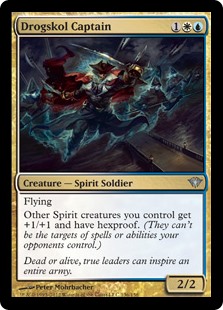 Collectively, every creature in Caleb’s deck (besides Noble Hierarch and Geist of Saint Traft) works to protect the team or interact with opposing spells in some way. Spell Queller eats spells, Selfless Spirit, Rattlechains, and Drogskol Captain protect the team, and Mausoleum Wanderer is an easy Judge's Familiar upgrade for free. With Rattlechains on the battlefield, everything has flash, which pairs nicely with Collected Company. Company, for its part, gives us the raw power at the top of our curve to make up for our individually weak elements. As with all tribal strategies, we will suffer when we draw nothing but lands and Noble Hierarch/Mausoleum Wanderer while our opponent casts Thoughtseize on our lone Collected Company, but we signed up for that when we sleeved up our deck.
Collectively, every creature in Caleb’s deck (besides Noble Hierarch and Geist of Saint Traft) works to protect the team or interact with opposing spells in some way. Spell Queller eats spells, Selfless Spirit, Rattlechains, and Drogskol Captain protect the team, and Mausoleum Wanderer is an easy Judge's Familiar upgrade for free. With Rattlechains on the battlefield, everything has flash, which pairs nicely with Collected Company. Company, for its part, gives us the raw power at the top of our curve to make up for our individually weak elements. As with all tribal strategies, we will suffer when we draw nothing but lands and Noble Hierarch/Mausoleum Wanderer while our opponent casts Thoughtseize on our lone Collected Company, but we signed up for that when we sleeved up our deck.
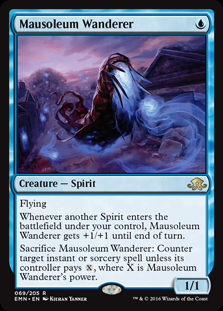 Overall, Caleb’s Spirits deck chooses to ride the line between aggro and midrange, slightly slower and less harder-hitting than Bant Eldrazi but much more reactive and tempo-like than any other creature deck in the field. With all of his fliers, most matchups will devolve into race situations as opponents realize they can’t block Caleb’s entire deck, and I like seeing two copies of Steel of the Godhead here as a way to suit up a pumped/protected Spell Queller and get to work. Giving our Geist of Saint Traft unblockable is fun as well, and I imagine Caleb got to live the dream and go Noble Hierarch/Geist of Saint Traft/Steel of the Godhead at least once over the course of the event.
Overall, Caleb’s Spirits deck chooses to ride the line between aggro and midrange, slightly slower and less harder-hitting than Bant Eldrazi but much more reactive and tempo-like than any other creature deck in the field. With all of his fliers, most matchups will devolve into race situations as opponents realize they can’t block Caleb’s entire deck, and I like seeing two copies of Steel of the Godhead here as a way to suit up a pumped/protected Spell Queller and get to work. Giving our Geist of Saint Traft unblockable is fun as well, and I imagine Caleb got to live the dream and go Noble Hierarch/Geist of Saint Traft/Steel of the Godhead at least once over the course of the event.
 Whether this archetype has legs for the long haul remains to be seen, but for now I’m definitely intrigued. A plethora of cheap removal spells should make Spell Queller a liability, but with Drogskol Captain, Rattlechains, and Selfless Spirit in place, getting those Lightning Bolts to resolve might prove impossible. Sweepers would usually be the answer to all this hexproof, but Spell Queller gets around Supreme Verdict’s uncounterable clause nicely (and good luck resolving Damnation against Mausoleum Wanderer too).
Whether this archetype has legs for the long haul remains to be seen, but for now I’m definitely intrigued. A plethora of cheap removal spells should make Spell Queller a liability, but with Drogskol Captain, Rattlechains, and Selfless Spirit in place, getting those Lightning Bolts to resolve might prove impossible. Sweepers would usually be the answer to all this hexproof, but Spell Queller gets around Supreme Verdict’s uncounterable clause nicely (and good luck resolving Damnation against Mausoleum Wanderer too).
Without testing, it seems to me the best way to fight this deck is either to just be faster (Burn/Affinity and pray) or take their hand apart à la Jund as I laid out in the scenario a couple paragraphs above. Noble Hierarch and Mausoleum Wanderer already give them about 30 slots worth of air, and their only payoff cards are really Drogskol Captain, Geist of Saint Traft, and Collected Company. Stop them from building a board and they're just spinning tires. That strategy sounds easy in theory, but their entire deck is built around slowly accumulating a board and keeping them around, so good luck. More testing here is needed.
Infect, by Joshua Collier (10th, SCG Milwaukee)
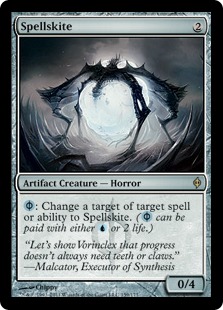 Joshua Collier’s Infect list isn’t revolutionary, by any means, but two maindeck Spellskite is spicy enough that it’s worth pointing out. I’m not interested specifically in Joshua’s exact list as I am in Infect as an archetype, because I believe (as I have for a couple weeks now) that Infect is the clear best deck in the format week to week. Blossoming Defense just made it better, and the archetype has finally reached the critical mass of pump spells needed to start brute-forcing their way to consistent turn-three wins. It’s still correct to play Infect patiently, of course, but if everyone was "going for it" as often as they had it I imagine we would all be talking the “b-word” sometime soon. I know that’s jumping ahead of things a lot, but really, Infect post-Kaladesh is just a monster. Part of it can be chalked up to Blossoming Defense, and part of it is just due to favorable metagame conditions, but I don't think this deck has a weak link anymore, besides the 12-infect-creature problem it always had (and it has done just fine so far with that).
Joshua Collier’s Infect list isn’t revolutionary, by any means, but two maindeck Spellskite is spicy enough that it’s worth pointing out. I’m not interested specifically in Joshua’s exact list as I am in Infect as an archetype, because I believe (as I have for a couple weeks now) that Infect is the clear best deck in the format week to week. Blossoming Defense just made it better, and the archetype has finally reached the critical mass of pump spells needed to start brute-forcing their way to consistent turn-three wins. It’s still correct to play Infect patiently, of course, but if everyone was "going for it" as often as they had it I imagine we would all be talking the “b-word” sometime soon. I know that’s jumping ahead of things a lot, but really, Infect post-Kaladesh is just a monster. Part of it can be chalked up to Blossoming Defense, and part of it is just due to favorable metagame conditions, but I don't think this deck has a weak link anymore, besides the 12-infect-creature problem it always had (and it has done just fine so far with that).
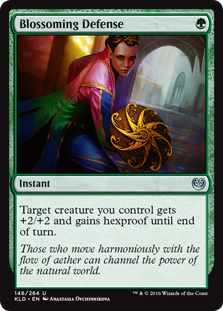 As for Joshua’s list, I’ve been playing around with Infect online recently, so I feel enough up to speed to start talking about particulars without risk of 100% embarrassing myself. Joshua is playing Pulse of Murasa, a Kitchen Finks with higher immediate impact that keeps us on Plan A, but personally I’ve been playing Finks myself. Against removal-heavy decks persist is excellent, and whether it’s giving us two attackers, two blockers, or eating two removal spells, Kitchen Finks is a card I turn to consistently (probably too much) after board.
As for Joshua’s list, I’ve been playing around with Infect online recently, so I feel enough up to speed to start talking about particulars without risk of 100% embarrassing myself. Joshua is playing Pulse of Murasa, a Kitchen Finks with higher immediate impact that keeps us on Plan A, but personally I’ve been playing Finks myself. Against removal-heavy decks persist is excellent, and whether it’s giving us two attackers, two blockers, or eating two removal spells, Kitchen Finks is a card I turn to consistently (probably too much) after board.
Beyond that, Distortion Strike has been unimpressive for me as I see it more of a game-one card, and I find myself already winning most game ones. Post-board, I’m not going all-in as much, relying more on Dispel and other reactive elements to nickel and dime my opponent while protecting myself from their blowout spells.
Takeaways
Across the Top 8, evidence of Infect and Dredge hate are everywhere. Three copies of Rest in Peace alongside Engineered Explosives in Caleb Durward’s Spirit list. Relic of Progenitus and more Explosives in Jeremy Jung’s 4th place Titan Shift list. Grafdigger's Cage and Scavenging Ooze in Micael Janny’s 7th place Zoo list. It seems to me that Infect and Dredge were known entities going into this event, and they performed well despite a relatively large amount of directed hate.
Still, there were a ton of Stony Silence floating around too, and Affinity did well, so I expect Dredge’s hate to increase, not decrease, moving forward. Hopefully most players look past the Top 8 results and see the five copies of Dredge in the Top 16, just begging for players to drop their guard so they can pounce on the format once again. Kent Ketter’s 3rd place finish should give most players looking to cut Dredge hate pause, which might in turn discourage some players from bringing Dredge to the Grand Prix.
Where the format goes in one week is tough to guess, but the continued lack of midrange (as Jund disappears entirely) is something to keep in mind. If Infect (possibly packing Kitchen Finks as a post-board plan) can find a way to fight through some middling amount of hate, it could find itself in prime position to take down a field distracted by other enemies. If I were playing in Dallas, that’s what I would play.
Thanks for reading,
Trevor Holmes
The_Architect on MTGO
Twitch.tv/Architect_Gaming
Twitter.com/7he4rchitect


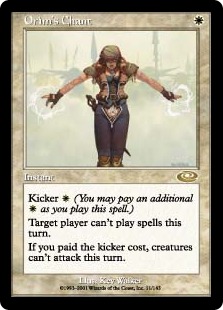


I know it just comes off as being a downer, but Infect makes me not want to play modern, especially not having a spare grand to build a deck that can beat it (especially since that just means I’d be what, 50/50?)
I find myself greatly enjoying Caleb’s Bant Spirits list (it’s nice to see an interactive and novel deck come out on top), though I think the Steel of the Godhead trick is the sort of thing you spring as a “gotcha” off the sideboard on people. As for how to beat it, being faster is a good plan – Spirits is not a fast deck, unless you live the dream and go Hierarch –> Geist –> Steel. The deck is fairly interactive, but a deck that can either dodge its interaction (Vial decks avoid Queller, for example) or is so fast that it can’t interact with it efficiently. As for how to define it, I would go with tempo – it’s an aggro-control deck with a deep creature lineup, which is classic Fish as defined by Jordan’s archetypes article.
Overall, though, I expect Burn to take advantage of the relative lack of hate (and of the abundant Infect, which it punishes ruthlessly) and re-carve out its niche. Seeing Titanshift up there is also interesting, as the deck is quietly accumulating an impressive resumé of late. I don’t know if I agree that Infect is the best deck in the format, but it’s definitely gotten better, and might be challenging Burn and Affinity for the #1 spot on the aggro totem pole sooner rather than later. Blossoming Defense has been awesome for me in testing, though I’m still wondering why Infect players don’t go for the “max protect” approach (which I’m defining as the maximum amount of Vines and Defenses, with an Apostle’s Blessing or two) when the deck’s main weakness is removal. Any thoughts on that?
What happened to Monday’s deck of the week?
That’s my bad. I’ve been running out of time, but I intend to bring it back asap.
Playing in Milwaukee last weekend it felt like Dredge was everywhere. The deck’s strong Day 2 finish may be due in part to overrepresentation, but I think it’s worth noting both Dredge decks in the Top 8 lost to Ad Nauseam, probably their worst matchup in the Top 16. I think you also missed the story on Burn: it tied Dredge for most played deck Day 2 (Top 71) at 11 copies but only put 2 decks in the Top 32. I have to think the Day 2 metagame was well prepared for Burn, which makes me think it’s likely a good matchup for Dredge since the rest of the metagame doesn’t seem particularly hostile. I do agree Infect remains in a pretty good spot: the rest of the top tier decks make it hard to justify playing cheap spot removal, but if Dredge can endure the hate Narcomoeba and Darkblast give it a decent matchup. Personally I’m looking for a combo deck like Ad Nauseam that doesn’t use the graveyard or artifacts but also has a passable Infect matchup. It’s not exactly going very well; right now my best lead seems to be Taking Turns.
Trevor, I think it’s really dangerous to focus so much on the top 8 – there’s often little-to-no difference in the swiss rounds at such a large tournament between a top 8 finish and a top 16 finish, other than tie breakers – so the “disparity” you draw attention to between top 16 and top 8 is only a razor-thin margin. Also, as one poster pointed out, Dredge only lost to Ad Nauseam in the top 8 (a great meta-game call by Samuel Jadin!), so I’m glad you pointed out that people should look past just the top 8.
I’d even suggest that analysis of this large-a-scale event should look at the top 32, as that still represents only the top 4% of the field, and there’s still not a big difference in winning percentages in the swiss between top 8 and top 32 (and individual differences can easily be explained by variance). Looking at the top 32 shows the following:
9 Dredge (5 top 16)
4 Infect (3 top 16)
3 Affinity (2 top 16)
2 Bant Eldrazi (1 top 16)
2 Titan Shift (1 top 16)
2 Burn (0 top 16)
2 GBx Midrange (0 top 16)
1 Bant Spirits (1 top 16)
1 Ad Nauseam (1 top 16)
1 Jeskai Control (1 top 16)
1 Zoo (1 top 16)
1 Grixis Delver (0 top 16)
1 Lantern Control (0 top 16)
1 Kiki Chord (0 top 16)
1 Sun and Moon (0 top 16)
Even with Dredge being tied for the most represented deck on day 2, 9 making top 32 and 5 in the top 16 is crazy. It was definitely Dredge’s weekend – and that’s even, as you pointed out, in the face of a lot of Dredge hate in the sideboards of those other decks. Possibly concerning, but too soon to say, in my opinion.
But even in the face of all the fast decks (19/32 trying to get you dead by the end of turn 4 – not including the 2 Titan Shift and 1 Ad Nauseam ), there were still control, midrange and tempo decks that made the top 32. Still shows that Modern is an open field – just make sure to bring your Dredge hate!
I mean…one control deck in the top 16 and you want to say the field is wide open? The problem with focusing too far OUT of the top 8 is that you give credit to decks that just had an okay performance.